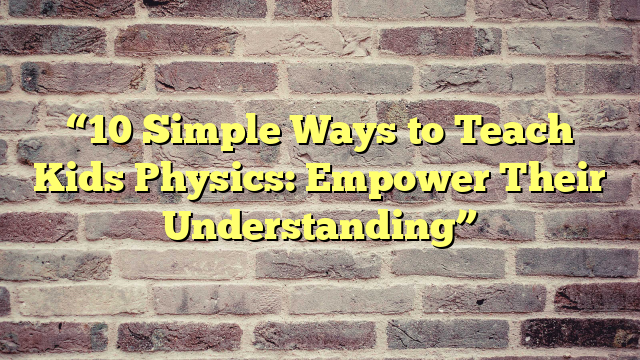Introduction
Physics is a fundamental subject that helps us understand the world around us. It explains the laws of nature and the principles that govern our daily lives. However, many kids find physics to be a difficult and boring subject. As parents and educators, it is our responsibility to make learning physics an enjoyable and empowering experience for children. In this article, we will discuss 10 simple ways to teach kids physics and empower their understanding.
1. Make It Relatable
Children are more likely to be interested in a subject if they can relate it to their own lives. When teaching physics, try to use real-life examples that children can understand and connect with. For example, you can explain the concept of gravity by showing them how a ball falls to the ground or how an apple falls from a tree. This way, they can see the practical application of the theories they are learning.
2. Use Visual Aids
Kids are visual learners, and using visual aids can greatly enhance their understanding of physics concepts. You can use diagrams, illustrations, videos, and animations to explain complex theories in a simple and engaging manner. This will not only make learning fun but also help children retain the information better.
3. Conduct Experiments
Children learn best by doing, and conducting simple experiments can be an effective way to teach them physics. You don’t need fancy equipment or a lab to do this. You can use everyday objects like balloons, magnets, and rulers to demonstrate the laws of physics. This hands-on approach will make learning more interactive and memorable for kids.
4. Encourage Questions
Encourage children to ask questions and be curious about the world around them. This will help them develop critical thinking skills and strengthen their understanding of physics. When children ask questions, it shows that they are actively engaged in the learning process, and it also gives you an opportunity to clarify any misconceptions they may have.
5. Use Games and Activities
Learning through play is a proven method to engage and educate children. You can use games and activities to teach kids physics in a fun and interactive way. For example, you can play a game of “hot and cold” to explain the concept of temperature or have a “paper airplane contest” to demonstrate the principles of aerodynamics. These activities will not only make learning enjoyable but also help children apply the theories they have learned.
6. Introduce Technology
In this digital age, children are surrounded by technology, and it can be a powerful tool to teach them physics. There are many educational apps, games, and simulations that can make learning physics more interactive and engaging. You can also use virtual reality to give children a first-hand experience of complex physics concepts, such as gravity and motion.
7. Use Everyday Language
Physics can be a complex subject, and using technical jargon can make it even more daunting for kids. When teaching physics, try to use everyday language that children can easily understand. Avoid using too many technical terms and explain the concepts in a simple and relatable manner. This will help children grasp the concepts better and make them feel more confident about their understanding.
Conclusion
Teaching physics to kids may seem like a challenging task, but with the right approach, it can be an enjoyable and empowering experience for both children and educators. By making it relatable, using visual aids, conducting experiments, encouraging questions, using games and activities, introducing technology, and using everyday language, we can help children develop a strong foundation in physics and spark their curiosity for the subject. Let’s empower our children with the knowledge and understanding of physics and inspire them to explore the wonders of the universe.

